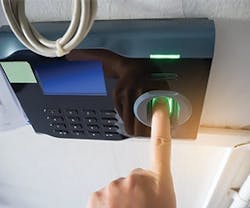Which Physical Biometric Technology Is Right for Your Facility?
Biometrics has been part of the public imagination for years, as the technology has played a big role in films and television. While it has been embellished and exaggerated in popular media, biometric technology is in many ways catching up with its fictional renditions.
“Biometric security has scaled up in many ways as the (research and development) has become more sophisticated,” says Ilya Umanskiy, Head of Diversified Solutions at Integrated Systems & Services. “Sensors are more robust now, and clients are looking beyond just the hand and fingerprint readers. People are trying to standardize facial recognition and are contemplating a variety of biometric authentication technologies. The spectrum of what is offered in the market has changed.”
Biometric security options have grown considerably. What kind of biometric security technology should you consider for your facility?
Related Content
Fingerprint and Hand Readers
Fingerprints traditionally have been the most common form of physical biometric identification. Fingerprint and hand readers emerged as the most common and still hold that distinction.
“We’ve seen a lot of changes over the years,” says Bill Giehler, Director of Operations at Integrated Systems & Services. “Back in the day, hand or finger readers were the most popular biometric formats. Finger reader technology was limited with sensors, but enrollment and capture are much better now.”
Some manufacturers are developing hand readers that require users to simply wave their hand for biometric identification, but most fingerprint and hand readers require contact, which can be a limitation for some facilities hoping to move people through faster. It becomes a cost discussion of cost, as other types of readers are usually more expensive.
Nevertheless, the processing and enrollment capabilities of fingerprint and hand readers have significantly improved.
“We have seen that in one-to-many configurations with a single authentication with the finger,” explains Giehler. “You walk up and put your finger down, and it searches through 10,000 templates to find your match. That technology has improved with better algorithms and stronger chips.”
A number of facilities pair fingerprint or hand readers with card readers. In that way, they can store the physical characteristics of a person on the card and reference that with the reader, a one-to-one configuration, allowing for identification that is more accurate while maintaining dual authentication.
Iris Recognition
One of the problems manufacturers have been working to improve with fingerprint readers is false rejects, explains Mark Clifton, CEO & President of Princeton Identity: “Fingerprints can have a problem where they get false rejects, like when your fingers get too dry. This often happens when you try to open up your iPhone, but it rejects your fingerprint.”
If you are hoping to avoid some of the problems with fingerprint and hand readers, you can eye another type of solution. Irises and other eye scans provide safe and highly accurate solutions.
“Irises have a significant amount of information compared to fingerprints and faces,” says Clifton. “The chances of having an imposter get in are very low with irises. The face and fingerprint are in the same ballpark, but it is much less likely to have an imposter to get through with an iris. If you are able to recognize two irises, the chance of someone falsely getting through is 1 in 1.4 trillion. It’s almost like DNA, it is so accurate.”
One reason irises are especially reliable in biometric identification is that they do not require contact, and they remain stable once a person reaches age 2 or 3. That means someone could theoretically enroll in a system when they are 3, and they will still be recognizable with that data at age 50, explains Clifton.
Unlike irises, fingerprints can change slightly over time, and facial recognition obviously cannot keep up very well with aging.
Find What Is Best for Your Facility
It is important to consider how your building is used to determine what kind of biometric security readers to implement. What works in one facility might be the wrong choice for another.
For example, Clifton recalls an athletic facility that implemented biometric readers that identified users based on the geometry of veins in their hands, which can typically be a reliable identifier. The problem was that after athletes had worked out, there was enough change due to sweat and dirt from exercise to cause the readers to misidentify people.
About the Author
Janelle Penny
Editor-in-Chief at BUILDINGS
Janelle Penny has been with BUILDINGS since 2010. She is a two-time FOLIO: Eddie award winner who aims to deliver practical, actionable content for building owners and facilities professionals.

